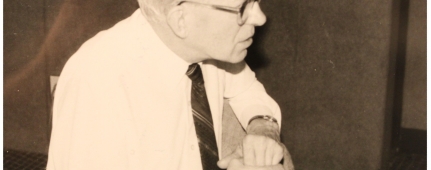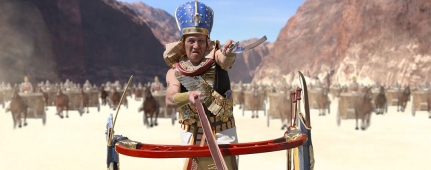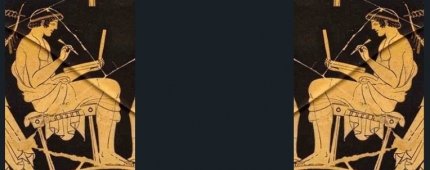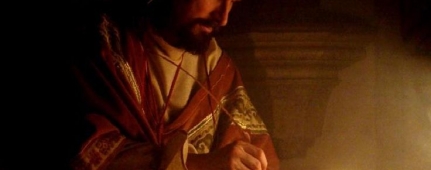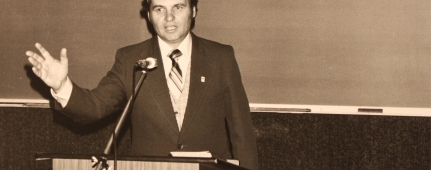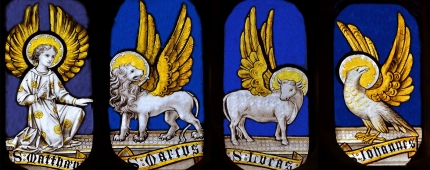The Early Fathers and the Resurrection of the Saints in Matthew 27:51-54
Copyright © 2014 Dr. Norman L. Geisler. All rights reserved.
The Biblical Passage in Question
Matthew wrote: “And behold, the curtain of the temple was torn in two, from top to bottom. And the earth shook, and the rocks were split. The tombs also were opened. And many bodies of the saints who had fallen asleep were raised, and coming out of the tombs after his resurrection they went into the holy city and appeared to many. When the centurion and those who were with him, keeping watch over Jesus, saw the earthquake and what took place, they were filled with awe and said, ‘Truly this was the Son of God’” (Mt. 27:51-54 ESV).
The Current Challenge to Its Historicity
In his book on The Resurrection of Jesus (RJ), Mike Licona speaks of the resurrection of the saints narrative in Matthew 27:51-54 as “a weird residual fragment” (RJ, 527) and a “strange report” (RJ, 530, 548, 556, emphasis added in these citations).1 He called it “poetical,” a “legend,” an “embellishment,” and literary “special effects” (see 306, 548, 552, and 553). He claims that Matthew is using a Greco-Roman literary genre which is a “flexible genre” in which “it is often difficult to determine where history ends and legend begins” (RJ, 34). Licona also believes that other New Testament texts may be legends, such as, the mob falling backward at Jesus claim “I am he” in John 18:4-6 (See RJ, 306, note 114) and the presence of angels at the tomb recorded in all four Gospels (Mt. 28:2-7; Mk. 16:5-7; Lk. 24:4-7; Jn. 20:11-14; see RJ, 185-186).
Licona cites some contemporary evangelical scholars in favor of his view, such as, Craig Blomberg who doubted historical authenticity of the miracle of the coin and the fish story in Matthew (Matt. 17:27).2 Blomberg also said, “All kinds of historical questions remain unanswered about both events [the splitting of the temple curtain and the resurrection of the saints]” (Matthew, electronic ed., 2001 Logos Library System; the New American Commentary [421]. Broadman and Holman, vol. 22). He also cites W. L. Craig, siding with a Jesus Seminar fellow Dr. Robert Miller, that Matthew added this story to Mark’s account and did not take it literally. Although he claims to believe it, Craig concluded that there are “probably only a few [contemporary] conservative scholars who would treat the story as historical” (from Craig’s comments in Paul Copan, Will the Real Jesus Please Stand Up? Baker, 1998). On the contrary, in terms of the broad spectrum of orthodox scholars down through the centuries, there are relatively “few” contemporary scholars who deny its authenticity, and they are overshadowed by the “many” (vast majority of) historic orthodox scholars who held to the historicity of this Matthew 27 resurrection of the saints.
The Evidence for Its Historicity
In spite of these contemporary doubts and denials, other scholars have pointed out the numerous indications of historicity in the Matthew 27:51-54 text itself, such as: (1) It occurs in a book that presents itself as historical (cf. Mt. 1:1,18); (2) Numerous events in this book have been confirmed as historical (e.g., the birth, life, deeds, teachings, death, and resurrection of Christ); (3) It is presented in the immediate context of other historical events, namely, the death and resurrection of Christ; (4) The resurrection of these saints is also presented as an event occurring as a result of the literal death and resurrection of Christ (cf. Mt. 27:52-53); (5) Its lineage with the preceding historical events is indicated by a series of conjunctions (and…and…and, etc.); (6) It is introduced by the attention getting “Behold” (v. 51) which focuses on its reality;3 (7) It has all the same essential earmarks of the literal resurrection of Christ, including: (a) empty tombs, (b) dead bodies coming to life, and (c) these resurrected bodies appearing to many witnesses; (8) It lacks and literary embellishment common to myths, being a short, simple, and straightforward account; (9) It contains element that are confirmed as historical by other Gospels, such as (a) the veil of the temple being split (Mk. 15:38; Lk. 23:45), and (b) the reaction of the Centurion (Mk. 15:39; Lk. 23:47). If these events are historical, then there is no reason to reject the other events, such as, the earthquake and the resurrection of the saints.
Further, it is highly unlikely that a resurrection story would be influenced by a Greco-Roman genre source (which Licona embraces) since the Greeks did not believe in the resurrection of the body (cf. Acts 17:32). In fact, bodily resurrection was contrary to their dominant belief that deliverance from the body, not a resurrection in the body, was of the essence of salvation. Homer said death is final and resurrection does not occur (Iliad 24.549-551). Hans-Josef Klauck declared, “There is nowhere anything like the idea of Christian resurrection in the Greco-Roman world” (The Religious Context of Early Christianity. Minneapolis: Fortress Press, 2000, p. 151).
D. A. Carson makes an interesting observation about those who deny the historicity of this text, saying, “One wonders why the evangelist, if he had nothing historically to go on, did not invent a midrash [legend] with fewer problems” (Carson, “Matthew” in Expositors Bible Commentary; Matthew, Mark, Luke, ed. Frank Gabelein. Zondervan, 1984, p. 581).
A Survey of the Great teachers of the Church on the Passage
Despite his general respect for the early Fathers, Mike Licona refers to the Father’s statements on this passage as “vague,” “unclear,” “ambiguous,” “problematic,” and “confusing.”4 However, this is clearly not the case, as the readers can see for themselves in the following quotations. For even though they differ on details, the Fathers surveyed are unanimous as to the historical nature of this event. Indeed, no one has given and clear and unambiguous evidence that any orthodox Father held that this passage was not historical. In the following passage we have highlighted their important words which affirm the literal and historical nature of the event.
The apostolic Father, Ignatius, was the earliest one to cite this passage, and Licona acknowledges that his writings “are widely accepted as authentic and are dated ca. A.D. 100-138 and more commonly to ca. A.D. 110” (Licona, RJ, 248). He adds that these writings provide “valuable insights for knowledge of the early second-century church…” (ibid.). If so, they are the earliest and most authentic verification of the historicity of the resurrection of the saints in Matthew 27 on record—one coming from a contemporary of the apostle John!
Ignatius to the Trallians
Ignatius affirmed clearly the literal historical nature of the resurrection of these saints, declaring, “For Says the Scripture, ‘Many bodies of the saints that slept arose,’ their graves being opened. He descended, indeed, into Hades alone, but He arose accompanied by a multitude” (chap.Ix, The Ante-Nicene Fathers, vol. I, p. 70).
Ignatius to the Magnesians (AD 70-115)
“…[T]herefore endure, that we may be found the disciples of Jesus Christ, our only Master—how shall we be able to live apart from Him, whose disciples the prophets themselves in the Spirit did wait for Him as their Teacher? And therefore He who they rightly waited for, being come, raised them from the dead”[Chap. IX] (Alexander Roberts and James Donaldson, eds. The Ante-Nicene Fathers, vol. I (1885). Reprinted by Grand Rapids, MI: Eerdmans, p. 62. Emphasis added in all these citations).6
Irenaeus (AD 120-200)
Irenaeus was also closely linked to the New Testament writers. He knew Polycarp who was a disciple of the apostle John. Irenaeus wrote: “…He [Christ] suffered who can lead those souls aloft that followed His ascension. This event was also an indication of the fact that when the holy hour of Christ descended [to Hades], many souls ascended and were seen in their bodies”(Fragments from the Lost Writings of Irenaeus XXVIII, Ante-Nicene Fathers, vol. I, Alexander Roberts, ibid., 572-573). This is followed (in XXIX) by this statement: “The Gospel according to Matthew was written to the Jews. For they had particular stress upon the fact that Christ [should be] of the seed of David. Matthew also, who had a still greater desire [to establish this point], took particular pains to afford them convincing proof that Christ is the seed of David…” (ibid., 573).
Clement of Alexandria (AD 155-200)
Another second century Father verified the historicity of the resurrection of the saints in Matthew 27, writing, “‘But those who had fallen asleep descended dead, but ascended alive.’ Further, the Gospel says, ‘that many bodies of those that slept arose,’—plainly as having been translated to a better state” (Alexander Roberts, ed. Stromata, Ante-Nicene Fathers, vol. II, chap. VI, 491).
Tertullian (AD 160-222)
The Father of Latin Christianity wrote: “’And the sun grew dark at mid-day;’ (and when did it ‘shudder exceedingly’ except at the passion of Christ, when the earth trembled to her centre, and the veil of the temple was rent, and the tombs burst asunder?) ‘because these two evils hath My People done’” (Alexander Roberts, ed. An Answer to the Jews, Chap XIII, Ante-Nicene Fathers, vol. 3, 170).
Hippolytus (AD 170-235)
“And again he exclaims, ‘The dead shall start forth from the graves,’ that is, from the earthly bodies, being born again spiritual, not carnal. For this he says, is the Resurrection that takes place through the gate of heaven, through which, he says, all those that do not enter remain dead” (Alexander Roberts, Ante-Nicene Fathers, vol. 5, The Refutation of All Heresy, BooK V, chap. 3, p. 54). The editor of the Ante-Nicene Fathers footnotes this as a reference to the resurrection of the saints in Matthew 27:52, 53 (in Note 6, p. 54.), as indeed it is.
Origen (AD 185-254)
Despite the fact that Origen was known for his Neoplatonic spritualizing of some biblical texts, Origen declared that Matthew 27 spoke of a literal historical resurrection of these saints. He wrote: “Now to this question, although we are able to show the striking and miraculous character of the events which befell Him, yet from what other source can we furnish an answer than the Gospel narratives, which state that ‘there was an earth quake, and that the rock were split asunder, and the tombs were opened, and the veil of the temple was rent in twain from top to bottom, an the darkness prevailed in the day-time, the sun failing to give light’” (Against Celsus, Book II, XXXIII. Alexander Roberts, ed. Ante-Nicene Fathers, vol. 4, 444-445).
“But if this Celsus, who, in order to find matter of accusation against Jesus and the Christians, extracts from the Gospel even passages which are incorrectly interpreted, but passes over in silence the evidences of the divinity of Jesus, would listen to divine portents, let him read the Gospel, and see that even the centurion, and they who with him kept watch over Jesus, on seeing the earthquake, and the events that occurred [viz., the resurrection of the saints], were greatly afraid, saying, ‘This man was the Son of God’” (Ibid., XXVI, p. 446).
Cyril of Jerusalem (c. AD 315-c. 386)
Early Fathers in the East also verified the historicity of the Matthew text. Cyril of Jerusalem wrote: “But it is impossible, some one will say, that the dead should rise; and yet Eliseus [Elisha] twice raised the dead,–when he was live and also when dead…and is Christ not risen? … But in this case both the Dead of whom we speak Himself arose, and many dead were raised without having even touched Him. For many bodies of the Saints which slept arose, and they came out of the graves after His Resurrection, and went into the Holy City, (evidently this city in which we now are,) and appeared to many” (Catechetical Lectures XIV, 16, Nicene Fathers, Second Series, vol. 7, p. 98).
Further, “I believe that Christ was also raised from the dead, both from the Divine Scriptures, and from the operative power even at this day of Him who arose,–who descended into hell alone, but ascended thence with a great company for He went down to death, and many bodies of the saints which slept arose through Him” (ibid., XIV, 18, vol. 7, p. 99).
Gregory of Nazianzus (c. AD 330-c. 389)
“He [Christ] lays down His life, but He has the power to take it again; and the veil rent, for the mysterious doors of Heaven are opened;5 the rocks are cleft, the dead arise. He dies but he gives life, and by His death destroys death. He is buried, but He rises again. He goes down to Hell, but He brings up the souls; He ascends to Heaven, and shall come again to judge the quick and the dead, and to put to the test such words are yours” (Schaff, ibid., vol. VII, Sect XX, p. 309).
Jerome (AD 342-420)
Speaking of the Matthew 27 text, he wrote: “It is not doubtful to any what these great signs signify according to the letter, namely, that heaven and earth and all things should bear witness to their crucified Lord” (cited in Aquinas, Commentary on the Four Gospels, vol. I, part III: St. Matthew (Oxford: John Henry Parker, 1841), 964.
“As Lazarus rose from the dead, so also did many bodies of the Saints rise again to shew forth the Lord’s resurrection; yet notwithstanding that the graves were opened, they did not rise again before the Lord rose, that He might be the first-born of the resurrection from the dead” (cited by Aquinas, ibid., 963).
Hilary of Poitiers (c. AD 315-c.357)
“The graves were opened, for the bands of death were loosed. And many bodies of the saints which slept arose, for illuminating the darkness of death, and shedding light upon the gloom of Hades, He robbed the spirits of death” (cited by Aquinas, ibid., 963).
Chrysostom (AD 347-407)
“When He [Christ] remained on the cross they had said tauntingly, He saved others, himself he cannot save. But what He should not do for Himself, that He did and more than that for the bodies of the saints. For if it was a great thing to raise Lazarus after four days, much more was it that they who had long slept should not shew themselves above; this is indeed a proof of the resurrection to come. But that it might not be thought that that which was done was an appearance merely, the Evangelist adds, and come out of the graves after his resurrection, and went into the holy city, and appeared unto many” (cited by Aquinas, ibid., 963-964).
St. Augustine (AD 354-430)
The greatest scholar at the beginning of the Middle Ages, St. Augustine, wrote: “As if Moses’ body could not have been hid somewhere…and be raised up therefrom by divine power at the time when Elias and he were seen with Christ: Just as at the time of Christ’s passion many bodies of the saints arose, and after his resurrection appeared, according to the Scriptures, to many in the holy city” (Augustine, On the Gospel of St. John, Tractate cxxiv, 3, Philip Schaff, Nicene and Post-Nicene Fathers, vol. VII, 448).
“Matthew proceeds thus: ‘And the earth did quake, and the rocks rent; and the graves were opened; and many bodies of the saints which slept arise, and come out of the graves after the resurrection, and went into the holy city, and appeared unto many.’ There is no reason to fear that these facts, which have been related only by Matthew, may appear to be inconsistent with the narrative present by any one of the rest [of the Gospel writers)…. For as the said Matthew not only tells how the centurion ‘saw the earthquake,’ but also appends the words [in v. 54], ‘and those things that were done’…. Although Matthew has not added any such statement, it would still have been perfectly legitimate to suppose, that as many astonishing things did place at that time…, the historians were at liberty to select for narration any particular incident which they were severally disposed to instance as the subject of the wonder. And it would not be fair to impeach them with inconsistency, simply because one of them may have specified one occurrence as the immediate cause of the centurion’s amazement, while another introduces a different incident” (St. Augustine, The Harmony of the Gospels, Book III, chap. xxi in Schaff, ibid., vol. VI, p. 206, emphasis added).
St. Remigius (c. 438-c. 533) “Apostle of the Franks”
“But someone will ask, what became of those who rose again when the Lord rose. We must believe that they rose again to be witnesses of the Lord’s resurrection. Some have said that they died again, and were turned to dust, as Lazarus and the rest whom the Lord raised. But we must by no means give credit to these men’s sayings, since if they were to die again, it would be greater torment to them, than if they had not risen again. We ought therefore to believe without hesitation that they who rose from the dead at the Lord’s resurrection, ascended also into heaven together with Him” (cited in Aquinas, ibid., 964).
Thomas Aquinas (1224-1274)
As Augustine was the greatest Christian thinker at the beginning of the Middle Ages, Aquinas was the greatest teacher at the end. And too he held to the historicity of the resurrection of the saints in Matthew 27, as is evident from his citations from the Fathers (with approval) in his great commentary on the Gospels (The Golden Chain), as all the above Aquinas references indicate, including Jerome, Hilary of Poitiers, Chrysostom, and Remigius (see Aquinas, ibid., 963-964).
John Calvin (1509-1564)
The chain of great Christian teachers holding to the historicity of this text continued into the Reformation and beyond. John Calvin wrote:
Matt. 27.52. And the tombs were opened. This was a particular portent in which God testified that His Son had entered death’s prison, not to stay there shut up, but to lead all free who were there held captive…. That is the reason why He, who was soon to be shut in a tomb opened the tombs elsewhere. Yet we may doubt whether this opening of the tombs happened before the resurrection, for the resurrection of the saints which is shortly after added followed in my opinion the resurrection of Christ. It is absurd for some interpreters to image that they spent three days alive and breathing, hidden in tombs. It seems likely to me that at Christ’s death the tombs at once opened; at His resurrection some of the godly men received breath and came out and were seen in the city. Christ is called the Firstborn from the dead (1 Cor. 15:20; Col. 1:18)…. This reasoning agrees very well, seeing that the breaking of the tombs was the presage of new life, and the fruit itself, the effect, appeared three days later, as Christ rising again led other companions from the graves with Himself. And in this sign it was shown that neither His dying nor His resurrection were private to himself, but breathe the odour of life into all the faithful (Calvin’s New Testament Commentaries, trans. A. W. Morrison. Eds. David and Thomas Torrance. Wm. B. Eerdmans, 1972, vol. 3, pp. 211-212).
Concluding Comments
Of course, there are some aspects of this Matthew 27 text of the saints on which the Fathers were uncertain. For example, there is the question as to whether the saints were resurrected before or after Jesus was and whether it was a resuscitation to a mortal body or a permanent resurrection to an immortal body. However, there is no reason for serious doubt that all the Fathers surveyed accepted the historicity of this account. Their testimony is very convincing for many reasons:
First, the earliest confirmation as to the historical nature of the resurrection of the saints in the Matthew 27 passage goes all the way back to Ignatius, a contemporary of the apostle John (who died. c. AD 90). One could not ask for an earlier verification that the resurrection of these saints than that of Ignatius (AD 70-115). He wrote: “He who they rightly waited for, being come, raised them from the dead”[Chap. IX]. And in the Epistle to the Trallians he added, “For Says the Scripture, ‘May bodies of the saints that slept arose,’ their graves being opened. He descended, indeed, into Hades alone, but He arose accompanied by a multitude” (chap.IX, The Ante-Nicene Fathers, vol. I, p. 70). The author who is a contemporary of the last apostle (John) is speaking unmistakably of the saints in Matthew 27 who were literally resurrected after Jesus was.
Second, the next testimony to the historicity of this passage is Irenaeus who knew Polycarp, a disciple of the apostle John. Other than the apostolic Fathers, Irenaeus is a good as any witness to the earliest post-apostolic understanding of the Matthew 27 text. And he made it clear that “many” persons “ascended and were seen in their bodies”(Fragments from the Lost Writings of Irenaeus XXVIII. Ante-Nicene Fathers, vol. I, ibid., 572-573).
Third, there is a virtually unbroken chain of great Fathers of the church after Irenaeus (2nd cent.) who took this passage as historical (see above). Much of the alleged “confusion” and “conflict” about the text is cleared up when one understands that, while the tombs were opened at the time of the death of Christ, nonetheless, the resurrection of these saints did not occur until “after his resurrection” (Mt. 27:53, emphasis added) 7 since Jesus is the “firstfruits” (1 Cor. 15:23) of the resurrection.
Fourth, the great church Father St. Augustine stressed the historicity of the Matthew 27 text about the resurrection of the saints, speaking of them as “facts” and “things that were done” as recorded by the Gospel “historians” (St. Augustine, The Harmony of the Gospels, Book III, chap. xxi in Schaff, ibid., vol. VI, p. 206, emphasis added).
Fifth, many of the Fathers used this passage in an apologetic sense as evidence of the resurrection of Christ. This reveals their conviction that it was a historical event resulting from the historical event of the resurrection of Christ. Irenaeus was explicit on this point, declaring, “Matthew also, who had a still greater desire [to establish this point], took particular pains to afford them convincing proof that Christ is the seed of David…” (Irenaeus, ibid., 573).
Some, like Chrysostom, took it as evidence for the resurrection to come. “For if it was a great thing to raise Lazarus after four days, much more was it that they who had long slept should not shew themselves above; this is indeed a proof of the resurrection to come” (cited by Aquinas, ibid., 963-964).
Origen understood it as “evidences of the divinity of Jesus” (Origen, ibid., Book II, chap. XXXVI. Ante-Nicene Fathers, 446). None of these Fathers would have given it such apologetic weight had they not been convinced of the historicity of the resurrection of these saints after Jesus’ resurrection in Matthew 27.
Sixth, even the Church Father Origen, who was the most prone to allegorizing away literal events in the Bible, took this text to refer to a literal historical resurrection of saints. He wrote of the events in Matthew 27 that they are “the evidences of the divinity of Jesus” (Origen, ibid., Book II, chap. XXXVI. Ante-Nicene Fathers, 446).
Seventh, some of the great teachers of the Church were careful to mention that the saints rose as a result of Jesus’ resurrection which is a further verification of the historical nature of the resurrection of the saints in Mathew 27. Jerome wrote: “As Lazarus rose from the dead, so also did many bodies of the Saints rise again to shew forth the Lord’s resurrection; yet notwithstanding that the graves were opened, they did not rise again before the Lord rose, that He might be the first-born of the resurrection from the dead” (cited by Aquinas, ibid., 963). John Calvin added, “Yet we may doubt whether this opening of the tombs happened before the resurrection, for the resurrection of the saints which is shortly after added followed in my opinion the resurrection of Christ. It is absurd for some interpreters to image that they spent three days alive and breathing, hidden in tombs.” For “It seems likely to me that at Christ’s death the tombs at once opened; at His resurrection some of the godly men received breath and came out and were seen in the city. Christ is called the Firstborn from the dead (1 Cor. 15:20; Col. 1:18” (Calvin’s New Testament Commentaries, vol. 3, pp. 211-212).
Eighth, St. Augustine provides an answer to the false premise of contemporary critics that there must be another reference to a New Testament event like this in order to confirm that it is historical. He wrote, “It would not be fair to impeach them with inconsistency, simply because one of them may have specified one occurrence as the immediate cause of the centurion’s amazement, while another introduces a different incident” (St. Augustine, ibid., emphasis added).
So, contrary to the claims of many current New Testament critics, the Matthew 27 account of the resurrection of the saints is a clear and unambiguous affirmation of the historicity of the resurrection of the saints. This is supported by a virtually unbroken line of the great commentators of the Early Church and through the Middle Ages and into the Reformation period (John Calvin). Not a single example was found of any Father surveyed who believed this was a legend. Such a belief is due to the acceptance of modern critical methodology, not to either a historical-grammatical exposition of the text or to the supporting testimony of the main orthodox teachers of the Church up to and through the Reformation Period.
Ninth, the impetus for rejecting the story of the resurrection of the saints in Matthew 27 is not based on good exegesis of the text or on the early support of the Fathers but is based on fallacious premises:
(1) First of all, there is an anti-supernatural bias beginning in the 17th century and lying beneath much of contemporary scholarship. But there is no philosophical basis for the rejection of miracles (see our Miracles and the Modern Mind, Grand Rapids: Baker, 1992), and there is no exegetical basis for rejecting it in this text. Indeed on the same ground one could reject the resurrection of Christ since it supernatural and is found in the same text.
(2) Further, there is also the fallacious premise of double reference which affirms that if an event is not mentioned at least twice in the Gospels, then its historicity is questioned. But on this grounds many other events must be rejected as well, such as, the story of Nicodemus (Jn. 3), the Samaritan woman at the well (Jn. 4), the story of Zaccchaeus (Lk. 19), the resurrection of Lazarus (Jn. 11), and even the birth of Christ in the stable and the angel chorus (Lk. 2), as well as many other events in the Gospels. How many times does an event have to be mentioned in a first century piece of literature based on reliable witnesses in order to be true?
(3) There is another argument that seems to infect much of contemporary New Testament scholarship on this matter. It is theorized that an event like this, if literal, would have involved enough people and graves to have drawn significant evidence of it in a small place like Jerusalem. Raymond Brown alludes to this, noting that “…many interpreters balk at the thought of many known risen dead being seen in Jerusalem—such a large scale phenomenon should have left some traces in Jewish and/or secular history!” 8 However, at best this is simply the fallacious Argument from Silence. What is more, “many” can mean only a small group, not hundreds of thousands. Further, the story drew enough attention to make it into one of the canonical Gospels, right along side of the resurrection of Christ and with other miraculous events. In brief, it is in a historical book; it is said to result from the resurrection of Christ; it was cited apologetically by the early Fathers as evidence of the resurrection of Christ and proof of the resurrection to come. No other evidence is needed for its authenticity.
A Denial of Inerrancy
According to the official statements by the International Council on Biblical Inerrancy (ICBI), the denial of the historicity of the Matthew 27 resurrection of the saints is a denial of the inerrancy of the Bible. This is clear from several official ICBI statements.
(1) The Chicago Statement on Inerrancy speaks against this kind of “dehistoricizing” of the Gospels, saying, “We deny the legitimacy of any treatment of the text or quest for sources lying behind it that leads to relativizing, dehistoricizing, or discounting its teaching, or rejecting its claims to authorship” (Article XVIII).
(2) The statement adds: “all the claims of the Bible must correspond with reality, whether that reality is historical, factual or spiritual” (Sproul, Explaining Inerrancy (EI), 43-44).
(3) ICBI framers said, “Though the Bible is indeed redemptive history, it is also redemptive history, and this means that the acts of salvation wrought by God actually occurred in the space-time world” (Sproul, EI, 37).
(4) Again, “When the quest for sources produces a dehistoricizing of the Bible, a rejection of its teaching or a rejection of the Bible’s own claims of authorship [then] it has trespassed beyond its proper limits (Sproul, EI, 55).
Subsequently, Sproul wrote: “As the former and only President of ICBI during its tenure and as the original framer of the Affirmations and Denials of the Chicago Statement on Inerrancy, I can say categorically that Mr. Michael Licona’s views are not even remotely compatible with the unified Statement of ICBI” (Letter, May 22, 2012, emphasis added).
Another ICBI founder, J.I. Packer, wrote: “As a framer of the ICBI statement on biblical inerrancy who once studied Greco-roman literature at advanced level, I judge Mike Licona’s view that, because the Gospels are semi-biographical, details of their narratives may be regarded a legendary and factually erroneous, to be both academically and theologically unsound” (Letter May 8, 2014).
(5) Also, “We deny that generic categories which negate historicity may rightly be imposed on biblical narratives which present themselves as factual” (Explaining Hermeneutics (EH), XIII). “We deny that any event, discourse or saying reported in Scripture was invented by the biblical writers or by the traditions they incorporated” (EH XIV bold added in all above citations).
(6) Finally, as a framer of the ICBI statements I can testify that Robert Gundry’s similar view of dehistoricizing Matthew were an object of these ICBI statements. And they lead to his being asked to resign from the Evangelical theological Society (by a 74% majority vote). Since Licona’s views do the same basic thing, then they should be excluded on the same basis. Gundry used Jewish Midrash genre to dehistoricized parts of Gospel history, and Licona used Greco-Roman genre and legends, but the principle is the same.
Notes:
1 Licona has subsequent questions about the certitude of his view on Matthew 27, but he has not retracted the view or the critical historical basis that led to the view.
2 Craig Blomberg, “A Constructive Traditional Response to New Testament Criticism,” in Do Historical Matters Matter to the Faith (Wheaton, IL: Crossway, 2012) 354 fn. 32.
3 Carl Henry noted that “Calling attention to the new and unexpected, the introductory Greek ide—See! Behold!—stands out of sentence construction to rivet attention upon God’s awesome intervention” (Henry, God Revelation and Authority.Texas: Word Books, 1976) 2:17-18.
4 Mike Licona, “When the Saints Go Marching in (Matthew 27:52-53): Historicity, Apocalyptic Symbol, and Biblical Inerrancy” given at the November, 2011 Evangelical Philosophical Society meeting.
5 Despite the curious phrase about the “mysterious doors of Heaven are opened” when the veil was split, everything in this passage speaks of literal death and literal resurrection of Christ and the saints after His death. The book of Hebrews makes the same claim that after the veil was split that Christ entered “once for all” into the most holy place (heaven) to achieve “eternal salvation” for us (Heb. 9:12).
6 See Alexander Roberts and James Donaldson, eds. Ignatius to the Magnesians in The Ante-Nicene Fathers, vol. I (1885), reprinted by Grand Rapids, MI: Eerdmans, p. 62. Emphasis added in all these citations.
7 See an excellent article clearing up this matter by John Wenham titled “When Were the Saints Raised?” Journal of Theological Studies 32:1 (1981): 150-152. He argues convincingly for repunctuating the Greek to read: “And the tombs were opened. The bodies of the sleeping saints were raised, and they went out from their tombs after the resurrection.” While this affects the alleged poetic flavor of the passage, it is certainly Bizzare to hold like some that the saints were raised at Christ’s death and then sat around the opened tombs for three days before they left. It also contradicts 1 Corinthians 15:20 which declares that Christ is the “firstfruits” of the resurrection and Matthew 27:53 which says they did not come out of the tombs until “after” the resurrection of Christ.
8 Raymond E. Brown, “Eschatological events Accompanying the Death of Jesus, Especially the Raising of the Holy ones from Their Tombs (Matt 27:51-53)” in John P. Galvin ed., Faith and the Future: Studies in Christian Eschatology (NY: Paulist Press, 1994), 64.



